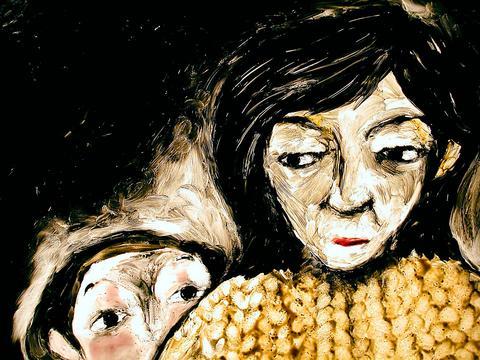"Welcome Taiwan" is showcasing 14 Taiwanese animations at the annual Annecy International Animated Film Festival in France, which takes place from June 7 to June 12.
The 40 year-old animation film festival is introducing animation films from Taiwan for the first time and the shorts will be screened at Bonlieu, at the festival venue.

PHOTO COURTESY OF CHINESE TAIPEI FILM ARCHIVE
The program consists of works by young filmmakers from Taiwan's top animation schools. With various sources and materials, the new generation of animation makers express a refreshing creativity.
Among the films in the program are: Mindscape (腦內風景) by Hsieh Pei-wen (謝珮雯), Two Sides (介) by Chiou Hsien-yuan (邱顯源) and Crossing Boundaries (越界) by Su Zhi-ming (蘇志明).
Mindscape is a well-delivered film composed of paint-on-glass effects. The picture confuses reality and imagination. An 80-year-old grandfather is getting dull-witted. In reality he is taken care of by his wife and granddaughter, but in his imagination he is a five-year-old kid, happily talking to people in his illusion.
Two Sides uses a combination of pencil on paper and 2D computer graphics. A man appears by the door of a factory looking for a job. A series of adventures starts when the iron door mysteriously opens by itself. There are strange machines which transform men into robots. Two Sides is an adventurous picture that comments on the standardization of the workplace.
Crossing Boundaries is mixed media: ink on paper and video. The picture intends to illustrate the rhythm and strokes of Chinese ink painting. Woven into the film are video images of a man doing meditation and the music of pounding drums by the Taipei Percussion Orchestra.
"These works can be seen as the new hope of Taiwan's
animation industry," said Chen yi-ching (
In the past, Taiwan's animation industry was only known for its manufacturing ability doing OEM (Original Equipment Manufacturing) works for Hollywood Studios such as Disney and Warner Brothers. The leading Taiwanese animation company Wang Films (宏廣動畫) was behind production work on Mulan, The Lion King, Lilo & Stitch and The Little Mermaid.
In the past 10 years the Tainan National College of Arts (國立台南藝術學院) and the National Taiwan University of Arts (國立台灣藝術大學) has fostered domestic talent and many artists at Welcome Taiwan come from the two schools.
Beginning two years ago, Taiwan's government increased its budgets for film assistance and set up programs to further develop the animation industry, in the hope of changing its image.
The two-year-old Taiwan International Animation Festival (台灣國際動畫影展), which is sponsored by the Government Information Office (新聞局, GIO) and organized by the Chinese Taipei Film Archive (國家電影資料館), provides an opportunity for local young artists to show their works to their fellow country people, as well as curators from overseas festivals, such as Annecy.
Compared to the achievements of Korea, however, Taiwan seems lackadaisical. This year at the Annecy International Animated Film Festival, there is an "Honoring Korea" special program, which is the largest special program of the festival this year.
The program showcases 50 animation films from Korea, including three animation features and 47 shorts. South Korea is an example of how an animation industry has grown from being an OEM factory to a fast-growing, self-sufficient animation industry, in 10 years.

The unexpected collapse of the recall campaigns is being viewed through many lenses, most of them skewed and self-absorbed. The international media unsurprisingly focuses on what they perceive as the message that Taiwanese voters were sending in the failure of the mass recall, especially to China, the US and to friendly Western nations. This made some sense prior to early last month. One of the main arguments used by recall campaigners for recalling Chinese Nationalist Party (KMT) lawmakers was that they were too pro-China, and by extension not to be trusted with defending the nation. Also by extension, that argument could be

Aug. 4 to Aug. 10 When Coca-Cola finally pushed its way into Taiwan’s market in 1968, it allegedly vowed to wipe out its major domestic rival Hey Song within five years. But Hey Song, which began as a manual operation in a family cow shed in 1925, had proven its resilience, surviving numerous setbacks — including the loss of autonomy and nearly all its assets due to the Japanese colonial government’s wartime economic policy. By the 1960s, Hey Song had risen to the top of Taiwan’s beverage industry. This success was driven not only by president Chang Wen-chi’s

Last week, on the heels of the recall election that turned out so badly for Taiwan, came the news that US President Donald Trump had blocked the transit of President William Lai (賴清德) through the US on his way to Latin America. A few days later the international media reported that in June a scheduled visit by Minister of National Defense Wellington Koo (顧立雄) for high level meetings was canceled by the US after China’s President Xi Jinping (習近平) asked Trump to curb US engagement with Taiwan during a June phone call. The cancellation of Lai’s transit was a gaudy

The centuries-old fiery Chinese spirit baijiu (白酒), long associated with business dinners, is being reshaped to appeal to younger generations as its makers adapt to changing times. Mostly distilled from sorghum, the clear but pungent liquor contains as much as 60 percent alcohol. It’s the usual choice for toasts of gan bei (乾杯), the Chinese expression for bottoms up, and raucous drinking games. “If you like to drink spirits and you’ve never had baijiu, it’s kind of like eating noodles but you’ve never had spaghetti,” said Jim Boyce, a Canadian writer and wine expert who founded World Baijiu Day a decade